The Anti-Static Control Products Market is estimated to be valued at USD 626.9 billion in 2025 and is projected to reach USD 1144.1 billion by 2035, registering a compound annual growth rate (CAGR) of 6.2% over the forecast period.
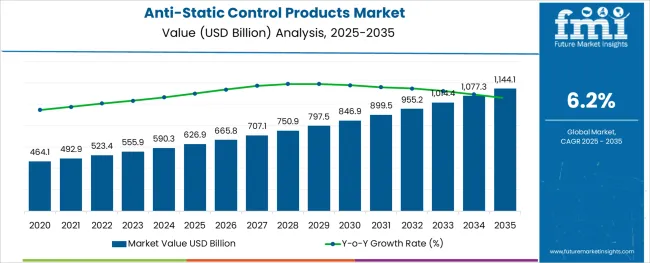
The anti-static control products market is experiencing consistent growth, driven by the increasing need to protect sensitive electronic components from electrostatic discharge. Industry trends indicate rising demand for effective packaging and handling solutions as electronic devices become more compact and complex. Enhanced awareness about static-related damage in electronics manufacturing and distribution has propelled the adoption of specialized anti-static products.
Continuous advancements in material science have enabled the production of more efficient and reliable anti-static materials. Moreover, expanding electronics manufacturing activities and rising consumer electronics consumption worldwide are further supporting market growth.
The market is expected to grow steadily with innovations in eco-friendly materials and improved product performance. Segmental expansion is forecasted to be led by Anti-Static Bags as the preferred product type, Electronics as the primary end-user industry, and Polyethylene (PE) as the favored material due to its versatility and effectiveness.
The market is segmented by Product Type, End Users, and Material and region. By Product Type, the market is divided into Anti-Static Bags, Anti-Static Surfaces, and Others. In terms of End Users, the market is classified into Electronics, Automotive, and Others. Based on Material, the market is segmented into Polyethylene (PE), Polyurethane (PU), Polypropylene (PP), and Polyethylene Terephthalate (PET). Regionally, the market is classified into North America, Latin America, Western Europe, Eastern Europe, Balkan & Baltic Countries, Russia & Belarus, Central Asia, East Asia, South Asia & Pacific, and the Middle East & Africa.
The market is segmented by Product Type, End Users, and Material and region. By Product Type, the market is divided into Anti-Static Bags, Anti-Static Surfaces, and Others. In terms of End Users, the market is classified into Electronics, Automotive, and Others. Based on Material, the market is segmented into Polyethylene (PE), Polyurethane (PU), Polypropylene (PP), and Polyethylene Terephthalate (PET). Regionally, the market is classified into North America, Latin America, Western Europe, Eastern Europe, Balkan & Baltic Countries, Russia & Belarus, Central Asia, East Asia, South Asia & Pacific, and the Middle East & Africa.
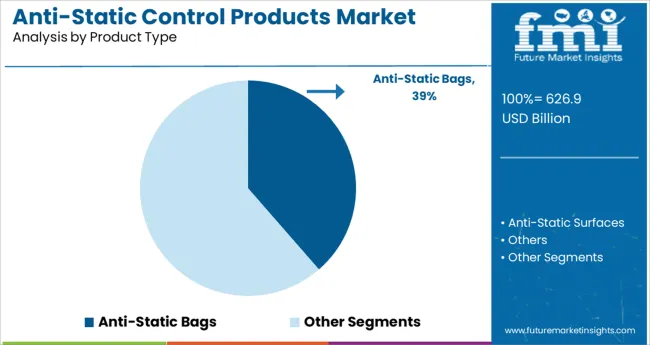
The Anti-Static Bags segment is expected to contribute 38.6% of the market revenue in 2025, positioning it as the leading product type. These bags are widely used due to their ability to shield sensitive electronic components from static electricity during storage and transportation. Their lightweight and flexible nature make them suitable for various packaging applications across electronics manufacturing and supply chains.
Advances in anti-static coating technologies have enhanced their protective properties, increasing their adoption. The segment benefits from the growing need to reduce product failures caused by static damage, which can result in costly recalls and repairs.
As electronic components become more sophisticated, the reliance on reliable packaging like anti-static bags is expected to increase, sustaining this segment’s growth.
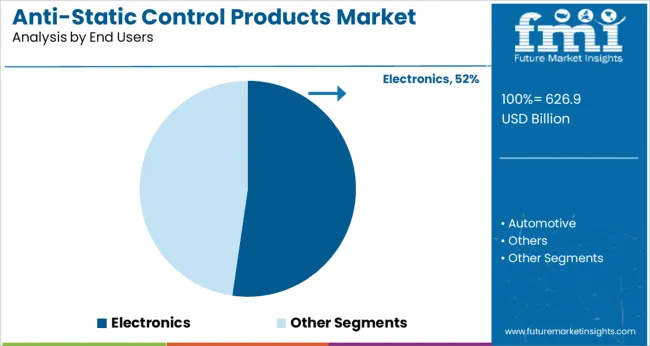
The Electronics segment is projected to hold 52.3% of the anti-static control products market revenue in 2025, maintaining its leadership position among end users. This growth is primarily attributed to the high vulnerability of electronic components to electrostatic discharge, which can impair functionality and reduce product lifespan.
Manufacturing plants, assembly lines, and distribution centers within the electronics sector have implemented strict static control measures to ensure product quality and reduce waste. The rising production of consumer electronics, semiconductors, and telecommunications devices has further amplified demand for anti-static products.
Additionally, regulatory guidelines and industry standards related to electrostatic discharge protection have compelled manufacturers to adopt comprehensive anti-static solutions. Given the critical role of static control in electronics production, this segment is expected to continue dominating the market.
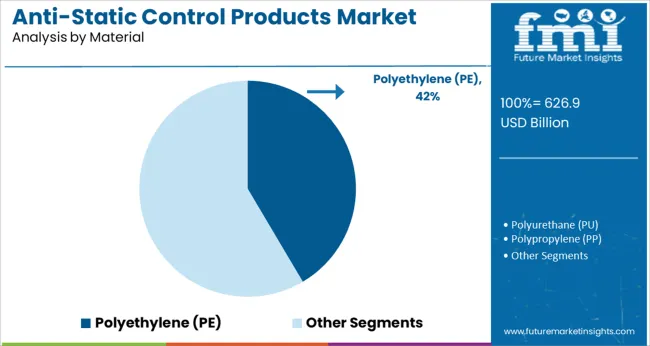
The Polyethylene (PE) segment is forecasted to capture 41.5% of the anti-static control products market revenue in 2025, establishing it as the leading material type. PE is favored for its excellent electrical insulating properties and adaptability in manufacturing processes. Its lightweight and durable characteristics make it ideal for producing anti-static bags and films that require flexibility and strength.
PE’s compatibility with various additives allows for enhanced anti-static functionality, improving product performance. The material is also cost-effective, supporting its widespread use in packaging applications across electronics and other industries.
Environmental considerations and recyclability efforts have led to innovations in PE formulations, further boosting its acceptance. As demand for reliable and economical anti-static materials grows, the PE segment is expected to maintain its market leadership.
New product innovations such as the introduction of the new antistatic bag in the packaging industry have contributed significantly to the growth of the antistatic control products market, along with escalated sales of antistatic control products and demand for antistatic control products. These bags are made of Polyethylene Terephthalate, and they have excellent shielding properties, which makes them the best option for packaging sensitive components and products.
In addition, the demand for antistatic control products, together with boosted sales of antistatic control products, is increased for electronics, digital signage, and gaming as it helps to reduce the static charge between the material surfaces. This factor is fueling the growth of the antistatic control products market together with the demand for antistatic control products, as well as boosted sales of antistatic control products.
Electrostatic discharge can cause latent or catastrophic damage to the electric components, resulting in great loss and total damage to the product. Thus antistatic control products are very crucial for the integrity and safety of electronic components.
Hence, antistatic control products are an integral part of the ESD control program, which is also propelling the growth of the sales of antistatic control products along with a surge in the antistatic control products market on the whole. Some antistatic control products, such as antistatic solutions and wipes, are very easy to use and can be sprayed on any surface to reduce static charging. The antistatic effect of such products lasts from weeks to months.
Moreover, it keeps areas dust-free and prevents static before it builds up, which is also one of the major factors driving the growth of the antistatic product controls market along with demand for antistatic control products and surging sales of antistatic control products.
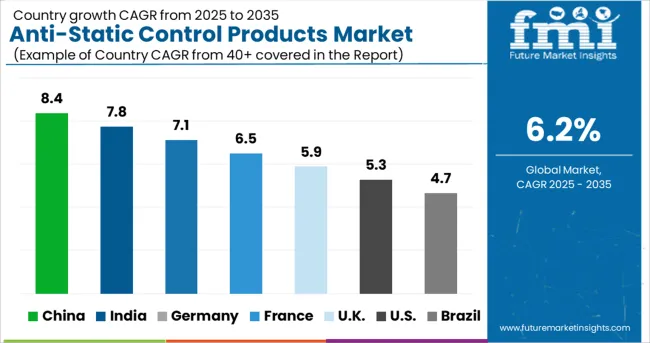
Increasing electrical and electronics activities in the Asia Pacific region are boosting the sales of antistatic control products in the region and the antistatic control products market on the whole, which is encouraging several antistatic control products market players to boost their manufacturing capacity.
Moreover, several antistatic control products market players are located in North America due to the growing electronics sector and digital electronics. Thus the demand for antistatic control products and sales of antistatic control products is increasing, which is fueling the growth of the antistatic control products market in this region.
The antistatic control products market report is a compilation of first-hand information, qualitative and quantitative assessments by industry analysts, and inputs from industry experts and industry participants across the value chain.
The report provides an in-depth analysis of parent antistatic control products market trends, macro-economic indicators, and governing factors, along with market attractiveness as per segment. The antistatic control products market report also maps the qualitative impact of various market factors on antistatic control products market segments and geographies.
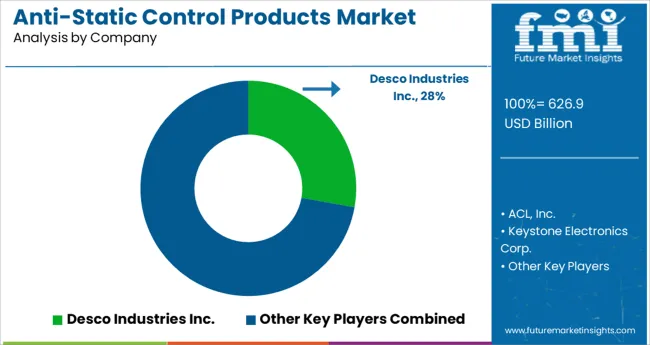
Some of the key players in the antistatic control products market are EIS Inc., Ted Pella, Inc., RS Components, and others.
Antistatic control products market players are competing with each other to gain the majority of actual certainties and share of the antistatic control products market with skyrocketing sales of antistatic control products. The antistatic control products market is a combination of both new as well as established players.
| Report Attribute | Details |
|---|---|
| Growth rate | CAGR of 6.2% from 2025 to 2035 |
| Base year for estimation | 2024 |
| Historical data | 2020 to 2024 |
| Forecast period | 2025 to 2035 |
| Quantitative units | Revenue in million and CAGR from 2025 to 2035 |
| Report coverage | Revenue forecast, volume forecast, company ranking, competitive landscape, growth factors, and trends, Pricing Analysis |
| Segments covered | Product type, end use, material type, region |
| Regional scope | North America; Western Europe, Eastern Europe, Middle East, Africa, ASEAN, South Asia, Rest of Asia, Australia and New Zealand |
| Country scope | USa.; Canada; Mexico; Germany; UK.; France; Italy; Spain; Russia; Belgium; Poland; Czech Republic; China; India; Japan; Australia; Brazil; Argentina; Colombia; Saudi Arabia; UAE; Iran; South Africa |
| Key companies profiled | EIS Inc., Ted Pella, Inc., RS Components and others |
| Customization scope | Free report customization (equivalent to up to 8 analysts’ working days) with purchase. Addition or alteration to country, regional & segment scope. |
| Pricing and purchase options | Avail customized purchase options to meet your exact research needs. |
The global anti-static control products market is estimated to be valued at USD 626.9 billion in 2025.
It is projected to reach USD 1,144.1 billion by 2035.
The market is expected to grow at a 6.2% CAGR between 2025 and 2035.
The key product types are anti-static bags, anti-static surfaces and others.
electronics segment is expected to dominate with a 52.3% industry share in 2025.






Our Research Products

The "Full Research Suite" delivers actionable market intel, deep dives on markets or technologies, so clients act faster, cut risk, and unlock growth.

The Leaderboard benchmarks and ranks top vendors, classifying them as Established Leaders, Leading Challengers, or Disruptors & Challengers.

Locates where complements amplify value and substitutes erode it, forecasting net impact by horizon

We deliver granular, decision-grade intel: market sizing, 5-year forecasts, pricing, adoption, usage, revenue, and operational KPIs—plus competitor tracking, regulation, and value chains—across 60 countries broadly.

Spot the shifts before they hit your P&L. We track inflection points, adoption curves, pricing moves, and ecosystem plays to show where demand is heading, why it is changing, and what to do next across high-growth markets and disruptive tech

Real-time reads of user behavior. We track shifting priorities, perceptions of today’s and next-gen services, and provider experience, then pace how fast tech moves from trial to adoption, blending buyer, consumer, and channel inputs with social signals (#WhySwitch, #UX).

Partner with our analyst team to build a custom report designed around your business priorities. From analysing market trends to assessing competitors or crafting bespoke datasets, we tailor insights to your needs.
Supplier Intelligence
Discovery & Profiling
Capacity & Footprint
Performance & Risk
Compliance & Governance
Commercial Readiness
Who Supplies Whom
Scorecards & Shortlists
Playbooks & Docs
Category Intelligence
Definition & Scope
Demand & Use Cases
Cost Drivers
Market Structure
Supply Chain Map
Trade & Policy
Operating Norms
Deliverables
Buyer Intelligence
Account Basics
Spend & Scope
Procurement Model
Vendor Requirements
Terms & Policies
Entry Strategy
Pain Points & Triggers
Outputs
Pricing Analysis
Benchmarks
Trends
Should-Cost
Indexation
Landed Cost
Commercial Terms
Deliverables
Brand Analysis
Positioning & Value Prop
Share & Presence
Customer Evidence
Go-to-Market
Digital & Reputation
Compliance & Trust
KPIs & Gaps
Outputs
Full Research Suite comprises of:
Market outlook & trends analysis
Interviews & case studies
Strategic recommendations
Vendor profiles & capabilities analysis
5-year forecasts
8 regions and 60+ country-level data splits
Market segment data splits
12 months of continuous data updates
DELIVERED AS:
PDF EXCEL ONLINE
Pest Control Products Market Size and Share Forecast Outlook 2025 to 2035
Oily Skin Control Products Market Analysis - Size and Share Forecast Outlook 2025 to 2035
Cleanroom and Lab Surface Contamination Control Products Market Size and Share Forecast Outlook 2025 to 2035
Control Network Modules Market Size and Share Forecast Outlook 2025 to 2035
Controllable Shunt Reactor for UHV Market Size and Share Forecast Outlook 2025 to 2035
Control Room Solution Market Size and Share Forecast Outlook 2025 to 2035
Control Knobs for Panel Potentiometer Market Size and Share Forecast Outlook 2025 to 2035
Controlled-Release Drug Delivery Technology Market Size and Share Forecast Outlook 2025 to 2035
Controlled Environment Agriculture (CEA) Market Size and Share Forecast Outlook 2025 to 2035
Control Cable Market Size and Share Forecast Outlook 2025 to 2035
Products from Food Waste Industry Analysis in Korea Size, Share and Forecast Outlook 2025 to 2035
Products from Food Waste in Japan - Size, Share, and Forecast Outlook 2025 to 2035
Control Towers Market Size and Share Forecast Outlook 2025 to 2035
Products from Food Waste Market Analysis - Size, Growth, and Forecast 2025 to 2035
Controlled & Slow Release Fertilizers Market 2025-2035
Antistatic Brush Market Growth – Trends & Forecast 2024-2034
Controlled Intelligent Packaging Market
Biocontrol Solutions Market Size and Share Forecast Outlook 2025 to 2035
Biocontrol Agents Market Size and Share Forecast Outlook 2025 to 2035
Oil Control Shampoo Market Size and Share Forecast Outlook 2025 to 2035

Thank you!
You will receive an email from our Business Development Manager. Please be sure to check your SPAM/JUNK folder too.
Chat With
MaRIA